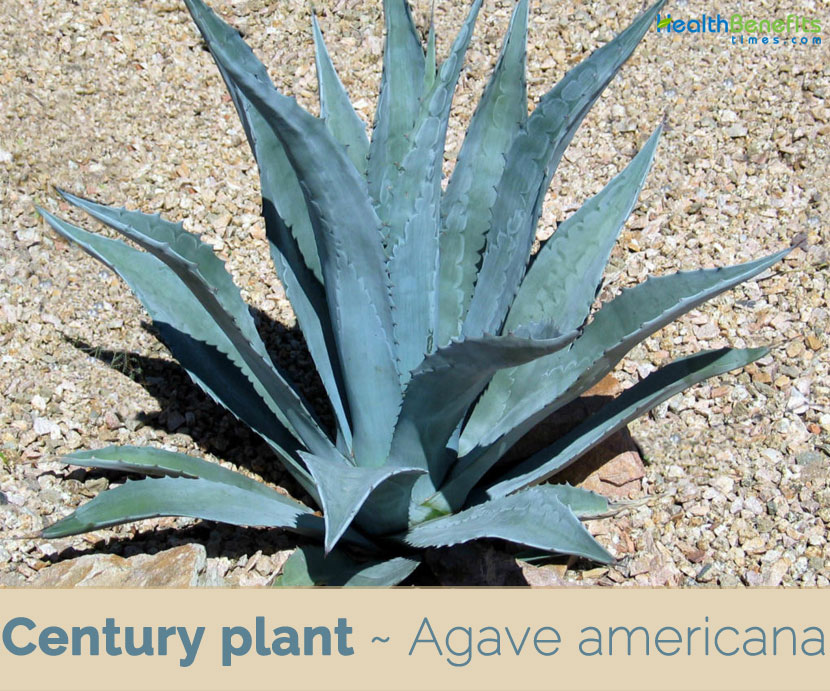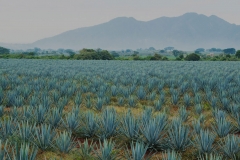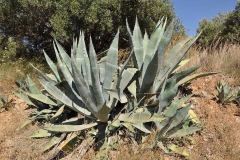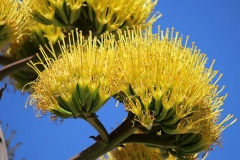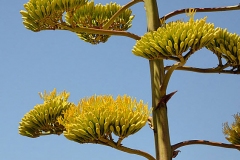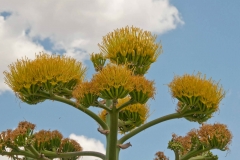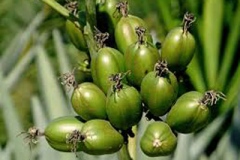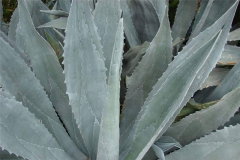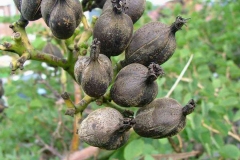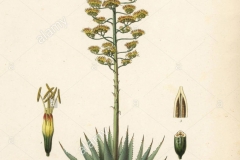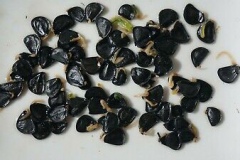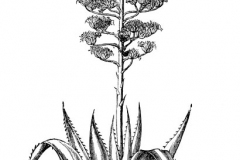| Century plant Quick Facts | |
|---|---|
| Name: | Century plant |
| Scientific Name: | Agave americana |
| Origin | Mexico, and the United States in New Mexico, Arizona and Texas |
| Colors | Green when young turning to brown or blackish in color as they mature |
| Shapes | Large oblong capsule that are about 3.5-8 cm long with a pointed tip |
| Taste | Sweet |
| Health benefits | Beneficial for Heal Wounds, Reduce Cholesterol Levels, Strengthen Hairs, Revitalizes Your Skin, Cures Indigestion, Constipation, Dysentery (Bloody Diarrhea), Gas (Flatulence), Jaundice, Bruises, Hair Loss, Cancer, Promoting Labor, Increasing Milk Supply |
| Name | Century plant |
|---|---|
| Scientific Name | Agave americana |
| Native | Mexico, and the United States in New Mexico, Arizona and Texas |
| Common Names | Century plant, American agave, American century plant, maguey, flowering aloe, American aloe, metl, spiked aloe, sentry plant, Blue Sisal, malina, Agave, yucca |
| Name in Other Languages | Afrikaans: Garingboom, Blou garingboom Albanian: Agave Arabic: Ghaf ‘amrikiin (أغاف أمريكي) Aragonés: Pita, Pino, Captu Armenian: Agavi amerikyan (Ագավի ամերիկյան), zarmuni (զարմունի), haryuramya halve (հարյուրամյա հալվե), shk’urr (շքուռ), perchatsaghik (պերճածաղիկ) Azerbaijani: Amerika aqavası Basque: Zurda, Agabe mexicar Bengali: Āgābhā āmērikānā (আগাভা আমেরিকানা) Brazil: Caroata-acu Bulgarian: Iztochen zyumbyul (източен зюмбюл) Catalan: Pal de mico, Pitera, Atzavara, Punyalera, Piterassa, Pitalassa, Pita americana, Maguei, Pita, Etsevara de tancas, Edzebara, Filiagulla, Fil y agulla, Figuerassa, Donarda, Atzavara de tanques, Atzabara, Atsavara, Atsabara, Arxavara, Arcebara, Agave, Adzabara, Adsevara, donarda, punyalera Chamorro: Maguey Chinese: long she lan (龙舌兰), Huá yán (华严) Croatian: Američka agava Czech: Agáve obecná Dutch: Honderdjarige aloe, Almindelig Agave Ecuador/Galapagos Islands: Cubuya negra, penco English: Sentry plant, American agave, American century plant, American-aloe, Centuryplant, Blue Sisal, malina, Agave, yucca Estonian: Ameerika agaav Finnish: Jättiagaave, Jättiagave French: Agave d’Amérique, Agave américain, langue à boeuf, choca, pite, faux aloes, pite, Agave Galician: Piteira, Pita, Herba dos pelados German: Hundert-jährige Agave, Amerikanische; Agave Greek: Alades, Alas, Athanatos, Lalas Hindi: Kamal cactus (कमल कैक्टस), Kantala, Gwarpatha (ग्वारपाठा) Hungarian: Közönséges agávé Italian: Agave, Pitta, Zabbara, Zammara, agave americana Japanese: Aonoryuuzetsuran (アオノリュウゼツラン), agave (アガベ) Kannada: Kantala Kazakh: Amerika agavasy (Америка агавасы) Lithuanian: Amerikinė agava Majorcan: Platanera bord, Pitra, Pita, Etsevara, Donardera, Adzebara, Adzabara Malayalam: Anakkaita (ആനക്കൈത) Manipuri: Kewa Marathi: Ghayapata (घायपात) Mizo: Kumza-pal Nepali: Kautukē (केतुके) Persian: آگاو برگخنجری Polish: Agawa amerykańska Portuguese: Agave-azul, Pita, Pita-azul, Piteira, Piteira-azul, Aloé-dos-cem-anos, Cacto-dos-cem-anos, Piteira-brava, Piteira-de-boi, cacto-da-praia, caroata-açu Quechua: Paqpa Romanian: Agavă Russian: Agava amerikanskaya (Агава американская) Sanskrit: Kantala Sicilian: Centuspati Scottish Gaelic: Àlas ceud bliadhna South Africa: garingboom; spreading century plant Spanish: Maguey americano, Acibara, Agabe, Atzavara, Atzavara de tanques, Azabara, Cabuya, Cardal, Maguey, Pita, Pitaco, Pitera, Agave Amarillo, cubuya negra, penco, pita común, henequen, cardon, cimbara, donarda, javila, pita comun, pitaca, piton, zabila, agave Swedish: Agave Tamil: Āṉaik kaṟṟāḻai (ஆனைக் கற்றாழை) Telugu: Amerikā kalabanda (అమెరికా కలబంద), Kittanara (కిత్తనార) Tunisian Arabic: Sbbar (صبّارة) Turkish: Amerika sabırı Ukrainian: Ahava amerykansʹka (Агава американська) Valencian: Pitera borda, Pitera, Pita, Atzavara Vietnamese: Thùa Welsh: Blodyn canmlwydd |
| Plant Growth Habit | Large, rhizomatous, suckering, evergreen monocarpic and long-lived succulent perennial plant |
| Growing Climates | Consolidated sand, cliffs, estuarine, other coastal areas, bluffs, rocky areas, inshore islands, dunes, savanna, disturbed sites, urban areas, woodlands, grasslands, riparian zones, beaches, hedges, valleys, slopes, arid and sandy places, along roadsides, pastures, grasslands |
| Soil | Well-drained, sandy, gravely soil, slightly acidic |
| Plant Size | About 6 feet tall by 8-10 feet wide |
| Stem | Short and thick |
| Leaf | Long and narrow (lanceolate) and arranged in a rosette. These leaves are 1-2 m long and 15-25 cm wide and are usually rigid and somewhat fleshy |
| Flowering season | March to June |
| Flower | Individual flowers are borne in an upright (erect) position on stalks (pedicels) 2-4 cm long |
| Fruit Shape & Size | Large oblong capsule that are about 3.5-8 cm long with a pointed tip (beaked apex) and consists of three compartments |
| Fruit Color | Green when young turning to brown or blackish in color as they mature |
| Propagation | By seeds, but also vegetatively by bulbils and rhizomes |
| Plant Parts Used | Leaves, roots, Gums, whole plant |
| Seed | Seeds are 6-8 mm long and are black in color and shiny in appearance |
| Taste | Sweet |
| Lifespan | Between 10 and 30 years |
| Available Forms | Infusion, powder, nectar |
| Health Benefits |
|
Plant Description
Century plant is a large, rhizomatous, suckering, evergreen monocarpic and long-lived succulent perennial plant that normally grows about 6 feet tall and 8-10 feet wide. The plant is found growing in consolidated sand, cliffs, estuarine, other coastal areas, bluffs, rocky areas, inshore islands, dunes, savanna, disturbed sites, urban areas, woodlands, grasslands, riparian zones, beaches, hedges, valleys, slopes, arid and sandy places, along roadsides, pastures, grasslands, open woodlands, coastal habitats, watercourses, desert, natural forests and riparian zones. The plant prefers well-drained, sandy, gravely soil, slightly acidic. It is tolerant of wind, salt, high temperatures, and extreme drought. It can grow in shallow, very dry, low fertility soil and can colonize bare sand.
Leaves
Large leaves at the base of the plant are long and narrow (lanceolate) and arranged in a rosette. They may be erect or ascending or spreading in nature, and are sometimes bent backwards near their tips. These leaves are 1-2 m long and 15-25 cm wide and are usually rigid and somewhat fleshy (succulent). They are normally bluish-grey (glaucous) to greyish-green in color, but forms with variegated leaves are relatively common. The leaf margins coarsely toothed (serrate), with prickly teeth (up to 1 cm long) borne at intervals of 2-6 cm. The leaves have a pointed tip (acute apex) topped with a large dark-brown colored spine that is 1.5-6 cm long. Leaves have stomata which open at night, taking in carbon dioxide.
Flowers
The massive flower clusters (1-8 m long) are borne at the top of a very robust flowering stem. These flower clusters are much-branched, with the branches being further divided towards their tips. Individual flowers are borne in an upright (erect) position on stalks (pedicels) 2-4 cm long. These flowers are 7-10.5 cm long and are yellow or greenish-yellow in color with their six ‘petals’ being fused together at the base into a short tube about 8-20 mm long. The flowers also have six very prominent stamens, consisting of stalks (filaments) 6-10 cm long and yellow anthers about 2.5-3.5 cm long. They also have a large ovary (3-4.5 cm long) topped with a style and three stigmas. Flowering normally takes place from March to June.
Fruits
Fertile flowers are followed by large oblong capsule that are about 3.5-8 cm long with a pointed tip (beaked apex) and consists of three compartments. These capsules turn from green to brown or blackish in color as they mature and eventually split open to release their seeds. The seeds are 6-8 mm long and are black in color and shiny in appearance. After flowering, the mature plants die.
Health benefits of Century plant
Century plants are rich in minerals like calcium, iron, and zinc. Minerals are very important for our health. It also consists of saponin which works great against cholesterol. And the use of agave nectar in the place of sugar is highly recommended by the doctors. Because it doesn’t help the sugar level goes high. Besides all these, Century plant has the following medicinal benefits.
1. Heal Wounds
Agave Americana is also known as American Aloe due to its topical applications on the wounds. Research concluded that applying Century plant extract on minor wounds and burns helps in healing them. The extract was collected from agave leaves using the percolation method.
2. Reduce Cholesterol Levels
Century plant consists of saponins, which help in lowering cholesterol levels in the body. Low cholesterol levels in the body reduce the risk of heart disease. In addition, saponins also prevent the growth of cancerous tumors.
3. Strengthen Hairs
Century plant can also be used to hydrate hair. Mix one tablespoon of agave nectar with any hair mask or add it to your conditioner. It’ll provide shine and strength to your hair and prevent hair loss and work on split ends too.
4. Revitalizes Your Skin
Century plant’s nectar consists of glycolic acid and essential antioxidants. It absorbs in the skin quickly and makes it look younger and less oily. It also works on controlling acne and reduces the inflammation of the skin as well.
5. Cures Indigestion
Century plant consists of prebiotic fibers which help our body nurture good bacteria. The presences of these bacteria eventually results in proper digestion.
6. Constipation
A good digestion system can eliminate the problem related to constipation. Fiber-based food works greatly to heal constipation.
7. Dysentery (Bloody Diarrhea)
Century plant leaves are supposed to be effective to cure dysentery. Before eating agaves, make sure that it is washed very well. And watch out the thorns.
8. Gas (Flatulence)
Century plant is fibrous. These fibers have some elements that fight against gastric pain. It decreases the gas formation in stomach according to gastrological research.
9. Jaundice (Excessive Bilirubin in the Blood)
Jaundice is not a fatal disease, but it can make your life worse. Chemical in Century plant is good for liver functions. Take 2 ml sap of Century plant with lukewarm water once a day to cure jaundice.
10. Bruises
The anti-inflammatory quality of Century plant is extensively known for excellent efficacy. Put some Century plant sap on the bruises and rub that evenly to help the skin heal.
11. Hair Loss
Hair loss is one of the global health issues at present. You can use agave plants to nourish the hair just like Aloe Vera.
12. Cancer
The saponins present in Century plant leaves can hinder the growth of cancer cells. Well! It can’t cure cancer, but it can earn a place in the list of cancer patients’ diet.
13. Promoting Labor
Pregnant women often face a problem with labor. They try to induce labor, but it becomes a tough job to accomplish. Century plant can help her in promoting labor.
14. Increasing Milk Supply
Drinking Pulque is a Mexican way to increase the milk supply for breastfeeding. This beverage helps the women increase milk production.
Traditional uses and benefits of Century plant
- Sap of Century plant has long been used in Central America as a binding agent for numerous powders used as poultices on wounds.
- Sap can also be taken internally in the treatment of diarrhea, dysentery etc.
- Sap is antiseptic, diaphoretic, diuretic and laxative.
- An infusion of the chopped leaf is purgative and the juice of the leaves is applied to bruises.
- Plant is used internally in the treatment of indigestion, flatulence, constipation, jaundice and dysentery.
- Sap has disinfectant properties and can be taken internally to check the growth of putrefactive bacteria in the stomach and intestines.
- Water in which Century plant fiber has been soaked for a day can be used as a scalp disinfectant and tonic in cases of falling hair.
- Steroid drug precursors are obtained from the leaves.
- Gum from the root and leaf is used in the treatment of toothache.
- Root is diaphoretic and diuretic and is used in the treatment of syphilis.
- It is also used in traditional medicine to treat cardiac problems, high blood pressure, gastro-intestinal problems and rheumatic pain.
- If the flower stem is cut before flowering, a sweet liquid called aguamiel (“honey water”) gathers in the hollowed heart of the plant. This can be fermented to produce the alcoholic drink called pulque.
- It is used externally as a medicinal herb to treat burns, bruises, minor cuts, injuries and skin irritation caused by insect bites.
- Juice from the Century plant has, for a long time, been used as a treatment for wounds in Central America.
- The Aztecs and Mayans used Century plant juice and egg whites to make a poultice that was then placed on wounds to speed healing.
- Traditionally, it was used internally to treat ulcers, stomach inflammation, tuberculosis, jaundice and other liver diseases, syphilis, and menstrual problems.
- Poultice made from the root and the leaves are often used to treat a toothache.
- Century plant was used as an herbal remedy for weak digestion, intestinal gas, and constipation.
- Juice has antibacterial properties and can be used internally to control the growth of decay bacteria in the stomach and intestines.
Ayurvedic Health benefits of Century plant
- UTI: Prepare a decoction of Century plant roots. Take one cup two times a day.
- Gonorrhea: Take out the pulp from the leaves of Century plant. Add Sugar. Have two tablespoon two times a day.
- Blood Impurity: Chop 4 g fresh leaves of Century plant. Make decoction. Drink once a day.
- Wounds: Crush leaves of Century plant to make paste. Apply it over Wound.
- Eyes: Use infusion of Century plant leaves as an Eye wash. It cures Irritation in Eyes.
- Jaundice: Take 2 ml sap of Century plant with lukewarm water. Have it once a day.
- Liver: Powder the dried leaves of Century plant. Take quarter tsp. twice a day with warm water.
- Anemia: Take 1 tsp. dried leaf powder of Century plant once a day. Have it with lukewarm water.
- Bruises: Apply the leaf juice on the affected parts.
Culinary Uses
- Heart of the plant is very rich in saccharine matter and can be eaten when baked.
- Seed can be ground into flour and used as a thickener in soups or used with cereal flours when making bread.
- Flower stalk can be roasted and used like asparagus.
- Sap can also be tapped by boring a hole into the middle of the plant at the base of the flowering stem.
- Century plant is used to brew an alcoholic liquor beverage in Mexico and South Africa.
- Sweet juice which is tapped from the flower stalks can be drunk or used to make an alcoholic beverage such as pulque or mescal.
Available Natural Forms
- Infusion: Dried leaves of the plant can be brewed into agave tea in order to extract its anti-inflammatory and gastro-protective properties. Infusion can also be applied topically to sanitize superficial wounds and skin irritations.
- Powder: Sap of agave is reduced and transformed into a fine powder that is used as a natural sweetener in beverages and desserts. Agave powder consists of prebiotic fiber, which is often consumed to improve digestive complaints.
- Nectar: Also known as agave syrup, it is a sweet liquid extracted from the roots of the plant. It has culinary uses and is also commonly advertised for diabetes management and weight loss diets; however, agave nectar is high in fructose, and it should be used in moderation.
Other Facts
- An extract of the leaves is used as soap.
- Strong fiber obtained from the leaves is used for making rope, coarse fabrics etc.
- Paper can also be made from the leaves.
- Thorns on the leaves are used as pins and needles.
- Dried flowering stems are used as a waterproof thatch and as a razor strop.
- Plants are used in land-reclamation schemes in dry areas of the world.
- This species is grown as an ornamental and hedge plant on all continents, except Antarctica.
- It is used a hedge plant and planted along contours for erosion control and for reclamation of denuded and overgrazed land.
- Leaves also yield fibers, known as pita, which are appropriate for making rope, matting, or coarse cloth.
- Leaves from both Agave Americana and the sisal agave are used to make woven mats and also to make paper.
- Plant takes between 10 and 25 years to flower, depending on climatic conditions.
Different uses of Century plant in daily life
Almost everyone thinks that the uses of agave plants are only limited to the production tequila and mezcal. This is actually a wrong conception about the uses of agave plants. Agave can do a lot more than that. There are approximately 200 species of agave. Some of them are considerably useful for many reasons. For this reason, they have occupied the world despite deriving from some parts of Mexico and USA. The various uses of agave plants are as follows.
Culinary Uses
If you have the ability of tasting traditional food, this will certainly intrigue you, because Native Americans had a tradition of roasting agave leaves in pits though it takes a couple of days to complete the process. People used to grind it to a powdery form and store it for years. This was of great use when there was a shortage of food. But, in modern time, agave is mostly known as an element of the production of tequila. It is more important use is being used as a replacement of sugar. Agave nectar is extracted from the pineapple-like pina/fruit of the agave plants. This is a natural sweeter which does not affect the sugar level of the human body. It is gluten free comprising a low glycemic index. So, it is good for health. Before using it as a sweetener, keep in mind that it is sweeter than regular sugar. So, you have to control the amount as per the need.
Daily Healthcare
Agave plants have a component named saponin in the roots and leaves. This is an element of soap. So, the extract of the agave plant can be turned into cleaning agents which will finally turn into soaps. Another great use of agave plant is you can use it as an anti-inflammatory and an antiseptic on wounds and cuts. Apply the fluid of agave plants to the cuts or wounds and rub it gently as an antiseptic.
DIY Purposes
Century plant leaf works as a naturally attached needle and thread. But the thread must be extracted with great care. Otherwise, the whole thing will turn into a complete mess. Remove the terminal thorn carefully. There will be complete fibers of a few feet. Pound the leaves slowly until the leaf flesh is fully removed. Then you will get the natural sewing kit made from agave plants. Use the fiber as thread and the thorn as needle and fix the things you want to patch up. Watch out the sharp thorns. They might find you off-guard and injure you. So use the agave plants in sewing and make a difference in your DIY sewing projects.
Household Essentials
Native Mexican has a tradition of making rope, paper, and firewood from agave plants. At first, the leaves are burnt or boiled. The burning process continues until it becomes charred. Then exclude everything from the remaining part except fibers. The remaining fibers can be mold into the shape of a rope. Though agave-made papers will not be of high quality, it is quite easy to make this. Peel the leaves and let them dry completely. This is a convenient way. The wastage produced from tequila preparation can also be turned into paper. Make a pulp using the fiber of the wastage and compress it to make paper. Stalk of the flowers is handy if we can use them as firewood. They are a good burning element if dry completely.
Uses in Home Improvement
Agave plants find their ways even in the desert area that made them adaptable to adverse hot climate. If your home situated somewhere hot with less water, they can be your best friends. Such weather damages the green plant, and your home may look pale without any green around it. Adopt some agave plants and put them in suitable pots or containers. It is a great landscaping choice for people living in dry places. Besides, you can use them to adorn your office too.
Uses in Fashion
Agave plants have great use as an element of tattoo preparation procedure. Agaves were extensively known to be related with tattoos. Thorns are fierce enough to be used as the needles. And don’t worry about the ink. Fleshy leaves are burnt and charred to make ink. So, you can use these natural needles and charcoal for designing tattoos. And, of course, natural materials are better than chemicals.
Prevention and Control
Control of Century plant is mostly attained by using a combination of physical and chemical management techniques. Using mechanical treatment to remove large individuals together with herbicides to control smaller plants delays invasion and allows recovery of natural vegetation. Combined mechanical and chemical control gave little recovery of the invasive plant four years after treatment in Tenerife.
Physical/Mechanical Control
Small infestations of A. Americana can be controlled by digging out small plants manually. Large plants can be moved by machinery. Care should be taken to dig out the taproot to prevent spread by suckering, and all pieces need to be disposed of properly.
Chemical Control
Large infestations of A. americana can be controlled by cutting down leaves close to the ground and painting the stump immediately with herbicide such as glyphosate and picloram + 2,4-D. Follow up treatment may be necessary, especially for larger plants.
Precautions
- Contact with the fresh sap can cause dermatitis in sensitive people.
- Plants have a very sharp and tough spine at the tip of each leaf. They need to be carefully sited in the garden.
- Avoid use during pregnancy and breast feeding.
- Large quantities of the herb can irritate the digestive system and even cause liver damage.
- Century Plant can trigger allergic reaction in some people and cause irritation and rashes.
- Caution is advised when the herb is collected and handled due to the sharp blades at the tip of the leaves.
References:
https://www.itis.gov/servlet/SingleRpt/SingleRpt?search_topic=TSN&search_value=182660#null
http://www.hear.org/pier/species/agave_americana.htm
https://npgsweb.ars-grin.gov/gringlobal/taxonomydetail.aspx?id=1690
https://pfaf.org/user/Plant.aspx?LatinName=Agave+americana
https://www.cabi.org/isc/datasheet/3851
http://www.missouribotanicalgarden.org/PlantFinder/PlantFinderDetails.aspx?taxonid=275719
http://www.floracatalana.net/agave-americana-l-
https://plants.usda.gov/core/profile?symbol=AGAM
https://en.wikipedia.org/wiki/Agave_americana
http://issg.org/database/species/ecology.asp?si=1664&fr=1&sts=&lang=EN
https://www.wildflower.org/plants/result.php?id_plant=AGAM
https://davesgarden.com/guides/pf/go/55351/#b
http://www.theplantlist.org/tpl1.1/record/kew-293578
http://www.llifle.com/Encyclopedia/SUCCULENTS/Family/Agavaceae/162/Agave_americana
https://gd.eppo.int/taxon/AGVAM
http://tropical.theferns.info/viewtropical.php?id=Agave+americana
http://www.flowersofindia.net/catalog/slides/Century%20Plant.html


